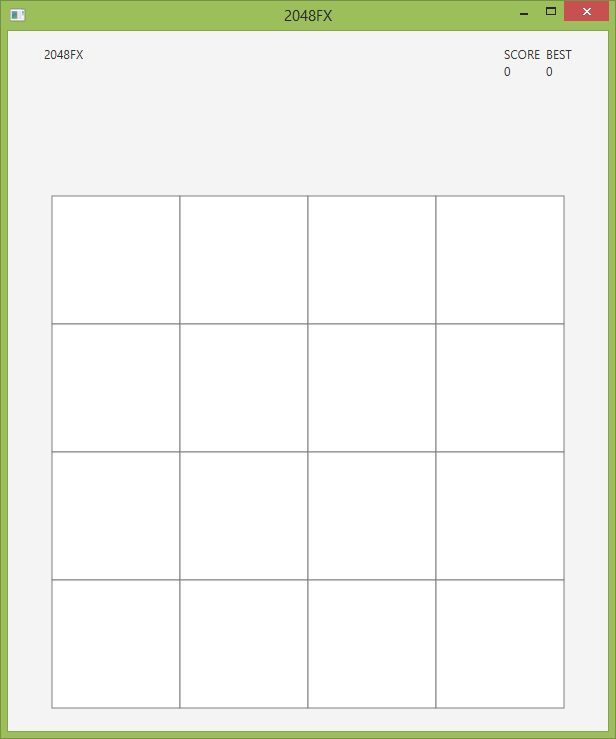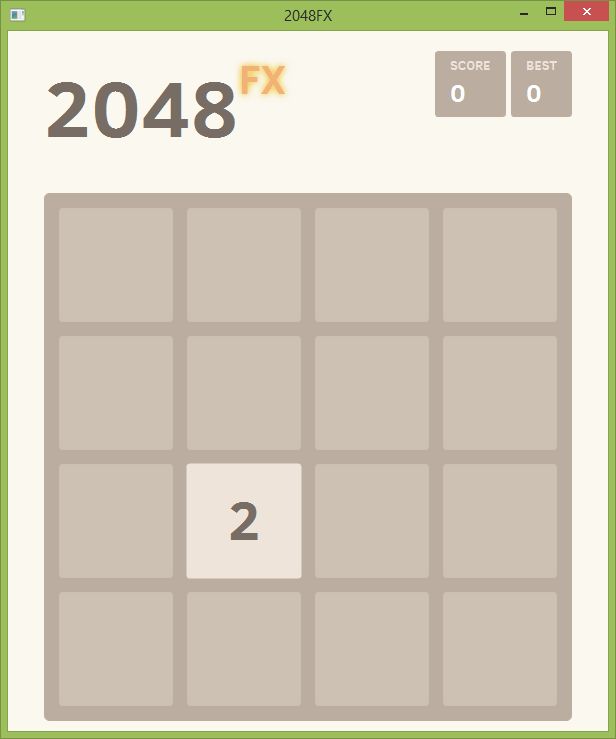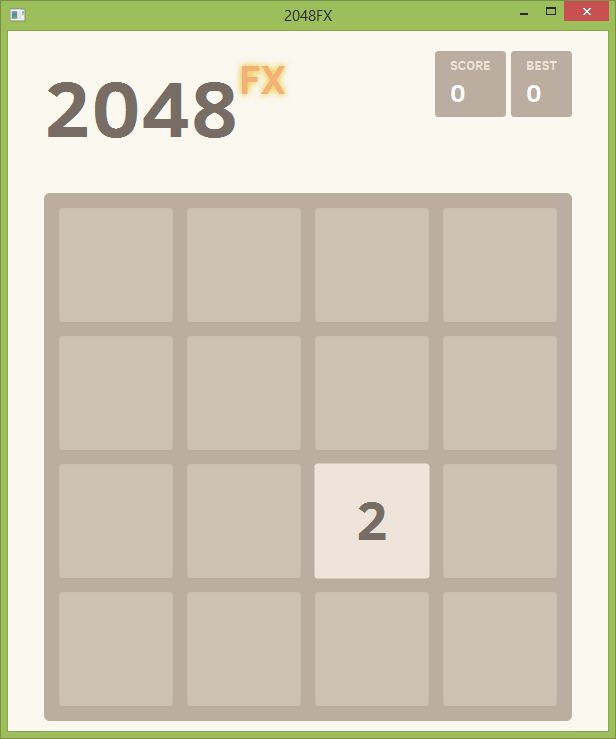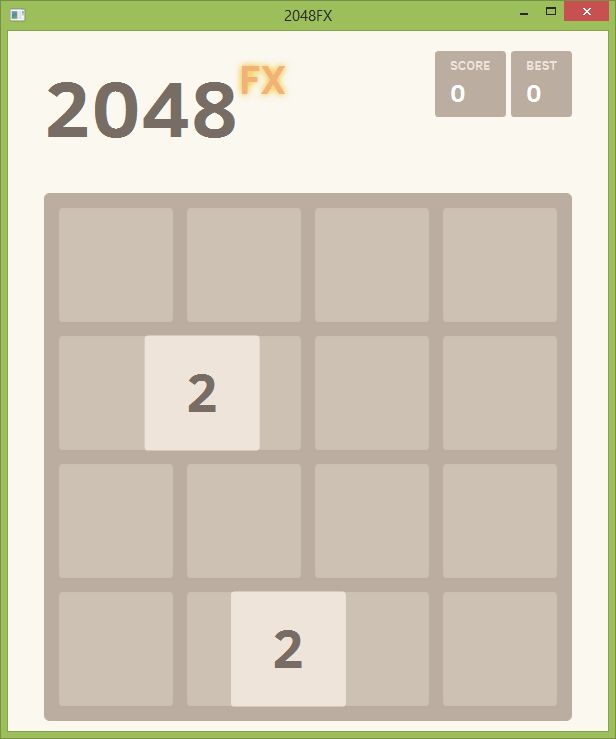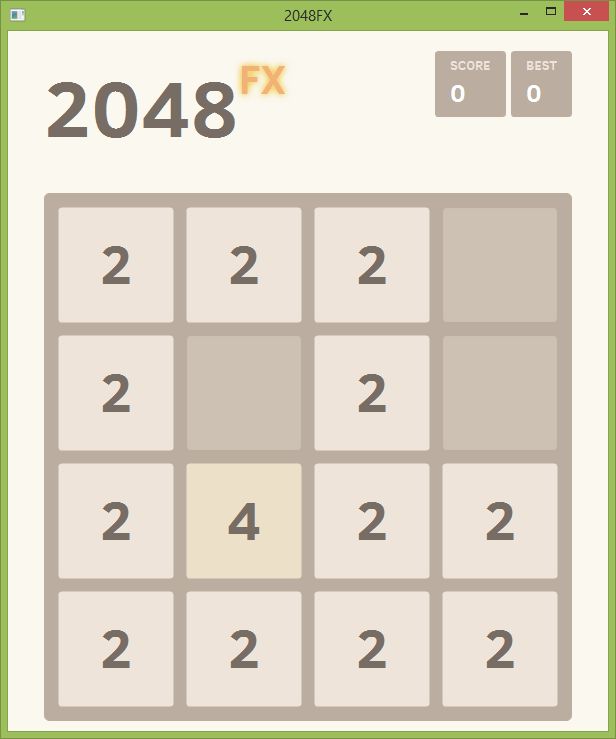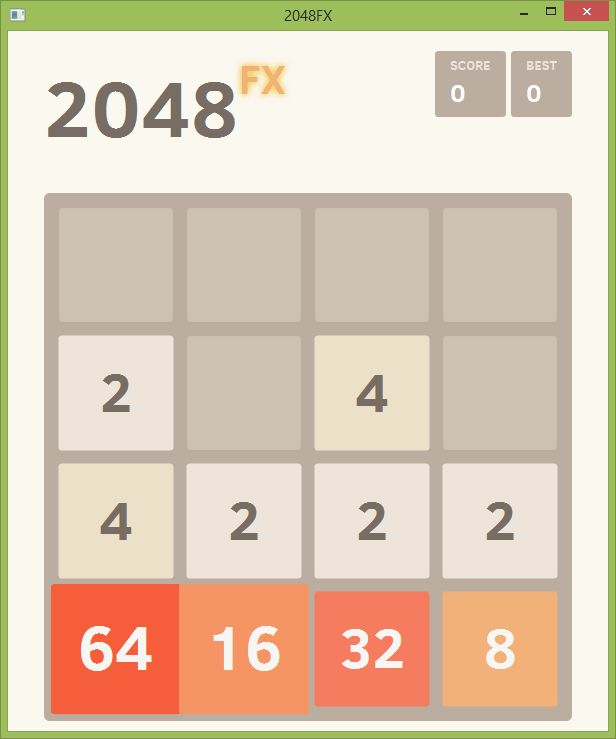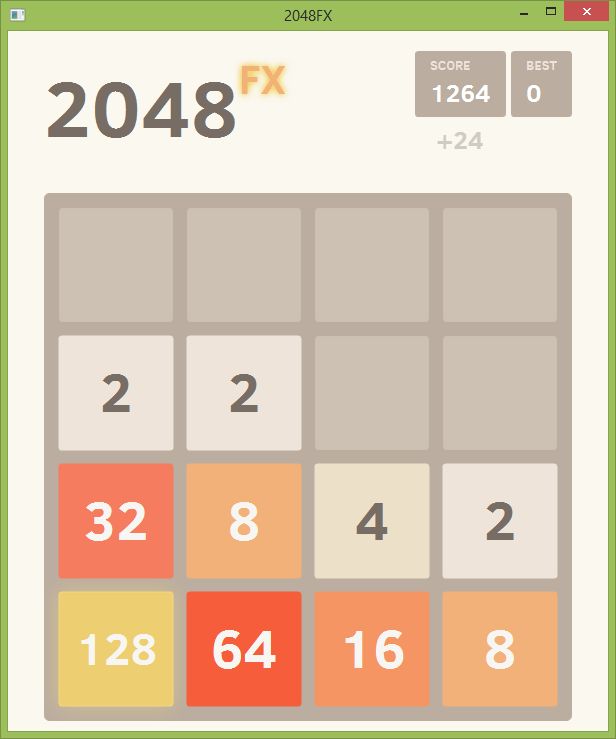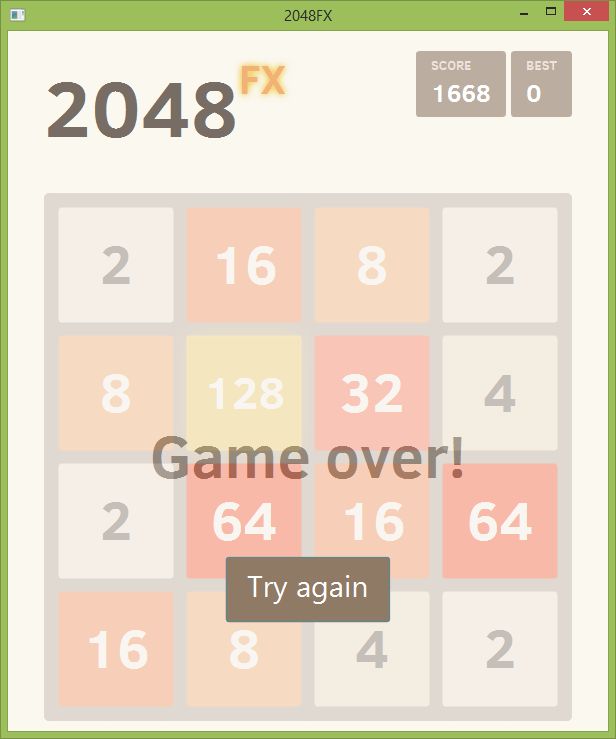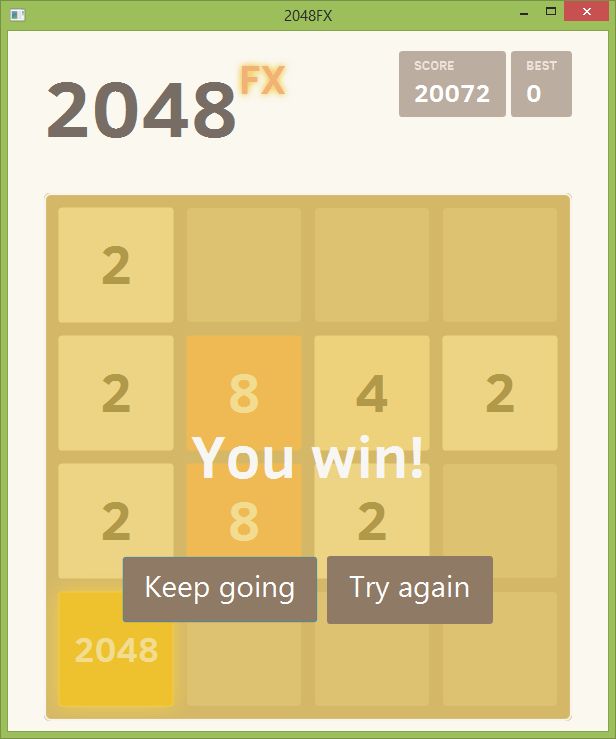By developing the famous game 2048 with JavaFX and Java 8 in this hands‐on lab session, you will encounter several new language features such as Stream API, lambda expressions, and new util classes and methods. You will also learn basic concepts of JavaFX 2‐D animations, parallel processing, UI design, CSS styling, and more.
Open the repo and have a look at the project:
https://github.com/jperedadnr/Game2048HOL.git
The starting project is a JavaFX application with the following Java classes:
- Game2048
- GameManager
- Board
- Tile
- Location
- Direction
- GridOperator
And the following resources to style the visual:
- game.css
- ClearSans‐Bold.ttf
Some classes and methods are lacking implementations. Follow this guide step by step to fullfil the missing code. Complete the methods and have a fully operative version of the game 2048 FX. Basically you’ll just have to copy and paste the snippets of code available on each step.
Please follow carefully every step. Try to build and run the application every now and then to check you didn’t miss any step and everything is in place. Fill free to ask any questions along the way.
Open NetBeans 8.0 and under Team ‐> Git select Clone ant type this URL:
https://github.com/jperedadnr/Game2048Empty.git
- Accept the default destination folder or choose one
- Select branch and click Next/Finish
- Wait till the local copy is created, and the project is opened in NetBeans
- Select Build and Run to test the (empty) application
Now follow these steps
10. CSS styling
12. Moving one tile
32. Adding points
33. Counting points
43. Optional tiles
46. Extra features
Create an instance of GameManager in Game2048 class and add it to the root object (StackPane).
- Class:
Game2048 - Method:
start - preview
- Copy and paste the following code snippet:
gameManager = new GameManager();
root.getChildren().add(gameManager);Back to Index
Create an instance of Board in GameManager class and add it to its list of children.
- Class:
GameManager - Method: constructor
- preview
- Copy and paste the following code snippet:
board = new Board();
getChildren().add(board);Back to Index
Create nodes for hTop in createScore(), with these steps:
- Create a
LabelnamedlblTitlewith text"2048"and other namedlblSubtitlewith text"FX" - Create an empty
HBoxnamedhFilland set its horizontal grow priority to grow always - Create a
VBoxnamedvScoresand anHBoxnamedhScoreswith spacing 5 - Create a
LabelnamedlblTitwith text"SCORE", and add it tovScore, as well aslblScore - Create a
VBoxnamedvRecordand aLabelnamedlblTitBestwith text"BEST", and add it tovRecord, as well aslblBest - Add
vScoreandvRecordtohScores, create aVBoxnamedvFillwith vertical grow priority to grow always, and addhScoresandvFilltovScores - Finally, add
lblTitle,lblSubtitle,hFillandvScorestohTop
- Class:
Board - Method:
createScore() - preview
- Copy and paste the following code snippet:
createScore() {
Label lblTitle = new Label("2048");
Label lblSubtitle = new Label("FX");
HBox hFill = new HBox();
HBox.setHgrow(hFill, Priority.ALWAYS);
VBox vScores = new VBox();
HBox hScores = new HBox(5);
Label lblTit = new Label("SCORE");
vScore.getChildren().addAll(lblTit, lblScore);
VBox vRecord = new VBox(0);
Label lblTitBest = new Label("BEST");
vRecord.getChildren().addAll(lblTitBest, lblBest);
hScores.getChildren().addAll(vScore,vRecord);
VBox vFill = new VBox();
VBox.setVgrow(vFill, Priority.ALWAYS);
vScores.getChildren().addAll(hScores,vFill);
hTop.getChildren().addAll(lblTitle, lblSubtitle, hFill,vScores);
}Call the method createScore() from the constructor of Board
- Class:
Board - Method: constructor
- preview
- Copy and paste the following code snippet:
createScore();Back to Index
Create a rectangle located in corners i*cell_size, j*cell_size, of size cell_sizexcell_size, filled with white color, and with border grey
- Class:
Board - Method:
createCell - preview
- Copy and paste the following code snippet:
cell = new Rectangle(i * CELL_SIZE, j * CELL_SIZE, CELL_SIZE, CELL_SIZE);
cell.setFill(Color.WHITE);
cell.setStroke(Color.GREY);Back to Index
Add 4x4 cells to gridGroup, by calling createCell method for every cell
- Class:
Board - Method:
createGrid - preview
- Copy and paste the following code snippet:
for(int i=0; i<4; i++){
for(int j=0; j<4; j++){
gridGroup.getChildren().add(createCell(i, j));
}
}Call method createGrid() from constructor of class Board
- Class:
Board - Method: constructor
- preview
- Copy and paste the following code snippet:
createGrid();Run the project to see the application after completing the first 5 steps
Back to Index
- Set the size of the tile to
Board.CELL_SIZE-13to account for the stroke width - For now, style the tile background with
#c9c9c9color - Set the tile alignement centered
- Assign the value from the argument to
value - Finally, set the text with this value, and initialized
mergedas false.
- Class:
Tile - Method: private constructor
- preview
- Copy and paste the following code snippet:
final int squareSize = Board.CELL_SIZE - 13;
setMinSize(squareSize, squareSize);
setMaxSize(squareSize, squareSize);
setPrefSize(squareSize, squareSize);
setStyle("-fx-background-color: #c9c9c9;");
setAlignment(Pos.CENTER);
this.value = value;
this.merged = false;
setText(Integer.toString(value));Back to Index
Create a new Tile instance, which value being 2 with a 90% possibility or 4 with the 10% remaining
- Class:
Tile - Method:
newRandomTile - preview
- Copy and paste the following code snippet:
return newTile(new Random().nextDouble() < 0.9 ? 2 : 4);Back to Index
Set the tile layout by getting from its location the position at the center of the cell and substracting half of the tile dimensions
- Class:
Board - Method:
moveTile - preview
- Copy and paste the following code snippet:
double layoutX = tile.getLocation().getLayoutX(CELL_SIZE) - (tile.getMinWidth() /
2);
double layoutY = tile.getLocation().getLayoutY(CELL_SIZE) - (tile.getMinHeight()
/ 2);
tile.setLayoutX(layoutX);
tile.setLayoutY(layoutY);Add a call to moveTile when a tile is added
- Class:
Board - Method:
addTile - preview
- Copy and paste the following code snippet:
moveTile(tile, tile.getLocation());Back to Index
Add a random tile a location of your choosing to the board
- Class:
GameManager - Method:
startGame - preview
- Copy and paste the following code snippet:
Tile tile0 = Tile.newRandomTile();
tile0.setLocation(new Location(1,2));
board.addTile(tile0);Add a call to startGame in the GameManager constructor
- Class:
GameManager - Method: constructor
- preview
- Copy and paste the following code snippet:
startGame();Run the project to see the application after completing the first 9 steps
Back to Index
Load the font ClearSans-Bold.ttf at the beginning of the application
- Class:
Game2048 - Method:
init - preview
- Copy and paste the following code snippet:
Font.loadFont(Game2048.class.getResource("ClearSans-Bold.ttf").toExternalForm(),10.0);Enable css styling in the application by loading the game.css file. Apply "game-root" selector to the root
- Class:
Game2048 - Method:
start - preview
- Copy and paste the following code snippet:
scene.getStylesheets().add(Game2048.class.getResource("game.css").toExternalForm());
root.getStyleClass().addAll("game-root");Apply the styles to nodes in the hTop container:
lblTitle:"game-label","game-title"lblSubtitle:"game-label","game-subtitle"vScoreandvRecord:,"game-vbox"lblScore:"game-label","game-score"lblTit:"game-label","game-titScore"lblTitBest:"game-label","game-titScore"lblBest:"game-label","game-score"
- Class:
Board - Method:
createScore - preview
- Copy and paste the following code snippet:
lblTitle.getStyleClass().addAll("game-label","game-title");
lblSubtitle.getStyleClass().addAll("game-label","game-subtitle");
vScore.getStyleClass().add("game-vbox");
lblTit.getStyleClass().addAll("game-label","game-titScore");
lblScore.getStyleClass().addAll("game-label","game-score");
vRecord.getStyleClass().add("game-vbox");
lblTitBest.getStyleClass().addAll("game-label","game-titScore");
lblBest.getStyleClass().addAll("game-label","game-score");Adjust arc size in cells to cell_size/6 and apply "game-grid-cell" style
- Class:
Board - Method:
createCell - preview
- Copy and paste the following code snippet:
cell.setArcHeight(CELL_SIZE/6d);
cell.setArcWidth(CELL_SIZE/6d);
cell.getStyleClass().add("game-grid-cell");Apply "game-grid" to gridGroup and "game-backGrid" to hBottom
- Class:
Board - Method:
createGrid - preview
- Copy and paste the following code snippet:
gridGroup.getStyleClass().add("game-grid");
hBottom.getStyleClass().add("game-backGrid");Apply to tiles the styles "game-label" and "game-tile-"+value, and remove
the previusly assigned style.
- Class:
Tile - Method: private constructor
- preview
- Copy and paste the following code snippet:
getStyleClass().addAll("game-label", "game-tile-" + value);Run the project to see the application after completing the first 10 steps
Back to Index
Return the enum constant of the type with the specified name from a KeyCode
- Class:
Direction - Method:
valueFor - preview
- Copy and paste the following code snippet:
return valueOf(keyCode.name());Back to Index
Return a new Location based on the actual and an offset in the specified direction
- Class:
Location - Method:
offset - preview
- Copy and paste the following code snippet:
return new Location(x + direction.getX(), y + direction.getY());Back to Index
- Get a list of tiles in the
gridGroupand then remove all the list from thegridGroup - Create new tiles based in the old ones, applying an offset in the specified direction
to their current location, checking if the new location is valid and it doesn't contain another tile.
Otherwise keep the previous location. Then add them to the
gridGroup
- Class:
GameManager - Method:
move - preview
- Copy and paste the following code snippet:
List<Tile> tiles=board.getGridGroup().getChildren().stream()
.filter(g->g instanceof Tile).map(t->(Tile)t)
.collect(Collectors.toList());
board.getGridGroup().getChildren().removeAll(tiles);
tiles.forEach(t->{
Tile newTile = Tile.newTile(t.getValue());
final Location newLoc=t.getLocation().offset(direction);
if(newLoc.isValidFor() &&
!tiles.stream().filter(t2->t2.getLocation().equals(newLoc)).findAny().isPresent()){
newTile.setLocation(newLoc);
} else {
newTile.setLocation(t.getLocation());
}
board.addTile(newTile);
});Back to Index
Add a listener to the scene for keys pressed, then get the key code, check if it is an arrow key. In such case get the direction for that arrow and move tile
- Class:
Game2048 - Method:
start - preview
- Copy and paste the following code snippet:
scene.setOnKeyPressed(ke -> {
KeyCode keyCode = ke.getCode();
if(keyCode.isArrowKey()){
Direction dir = Direction.valueFor(keyCode);
gameManager.move(dir);
}
});Run the project to see the application after completing the first 14 steps. Press the right arrow and check the tile from Screenshot #10 moves one cell to the right
Back to Index
Clear the gameGrid map and the locations list, and then initialize both with all 4x4 valid locations, and null tiles
- Class:
GameManager - Method:
initializeGameGrid - preview
- Copy and paste the following code snippet:
gameGrid.clear();
locations.clear();
for(int i=0; i<4; i++){
for(int j=0; j<4; j++){
Location location = new Location(i,j);
locations.add(location);
gameGrid.put(location, null);
}
}Call initializeGameGrid before startGame
- Class:
GameManager - Method: constructor
- preview
- Copy and paste the following code snippet:
initializeGameGrid();
gameGrid.clear();Back to Index
Shuffle a copy of locations list, and add two random tiles at the first two locations of the shuffled
list to gameGrid and call redrawTilesInGameGrid
- Class:
GameManager - Method:
startGame - preview
- Copy and paste the following code snippet:
List<Location> locCopy=locations.stream().collect(Collectors.toList());
Collections.shuffle(locCopy);
tile0.setLocation(locCopy.get(0));
gameGrid.put(tile0.getLocation(), tile0);
Tile tile1 = Tile.newRandomTile();
tile1.setLocation(locCopy.get(1));
gameGrid.put(tile1.getLocation(), tile1);
redrawTilesInGameGrid();Add to the board all valid tiles in gameGrid
- Class:
GameManager - Method:
redrawTilesInGameGrid - preview
- Copy and paste the following code snippet:
gameGrid.values().stream().filter(Objects::nonNull).forEach(board::addTile);Back to Index
Search for the farthest location a tile can be moved in the specified direction, over empty cells and inside the grid
- Class:
GameManager - Method:
findFarthestLocation - preview
- Copy and paste the following code snippet:
do {
farthest = location;
location = farthest.offset(direction);
} while (location.isValidFor() && gameGrid.get(location)==null);Back to Index
Instead of using board.gridGroup from Step 13 to move the tiles, we'll use now gameGrid,
using a double IntStream to traverse the grid.
For every valid tile:
- Find the farthest location possible.
- If it's different from the actual one:
- Set its layout with
board.moveTile() - Update
gameGridin the old location with null - Update
gameGridwith the tile in the new location, - Finally set the location of the tile.
- Set its layout with
Note: There's an issue with this approach, as the followed order is from top to bottom or left to right. The first tiles can't be moved as the next ones hasn't been moved jet, and they get stuck. This will be addressed later on.
- Class:
GameManager - Method:
move - preview
- Copy and paste the following code snippet:
IntStream.range(0, 4).boxed().forEach(i->{
IntStream.range(0, 4).boxed().forEach(j->{
Tile t=gameGrid.get(new Location(i,j));
if(t!=null){
final Location newLoc=findFarthestLocation(t.getLocation(),direction);
if(!newLoc.equals(t.getLocation())){
board.moveTile(t, newLoc);
gameGrid.put(newLoc, t);
gameGrid.replace(t.getLocation(),null);
t.setLocation(newLoc);
}
}
});
});Back to Index
Animate the tile translation from its actual location to the new one, in 65 ms.
- Class:
GameManager - Method:
animateExistingTile - preview
- Copy and paste the following code snippet:
KeyValue kvX = new KeyValue(tile.layoutXProperty(),
newLocation.getLayoutX(Board.CELL_SIZE) - (tile.getMinHeight() / 2),
Interpolator.EASE_OUT);
KeyValue kvY = new KeyValue(tile.layoutYProperty(),
newLocation.getLayoutY(Board.CELL_SIZE) - (tile.getMinHeight() / 2),
Interpolator.EASE_OUT);
KeyFrame kfX = new KeyFrame(Duration.millis(65), kvX);
KeyFrame kfY = new KeyFrame(Duration.millis(65), kvY);
timeline.getKeyFrames().add(kfX);
timeline.getKeyFrames().add(kfY);Back to Index
All the tile animations will be executed at the same time using a ParallelTransition.
While playing no movement will be allowed. Use the volatile movingTiles to exit move when it's true
- Class:
GameManager - Method:
move - preview
- Copy and paste the following code snippet:
synchronized (gameGrid) {
if (movingTiles) {
return;
}
}While traversing the grid with valid tiles, add those that are moving to the parallelTranstion,
instead of using board.moveTile
- Class:
GameManager - Method:
move - preview
- Copy and paste the following code snippet:
parallelTransition.getChildren().add(animateExistingTile(t, newLoc));Add a listener to find when the animations have finished, and there set movingTiles to false
- Class:
GameManager - Method:
move - preview
- Copy and paste the following code snippet:
parallelTransition.setOnFinished(e -> {
synchronized (gameGrid) {
movingTiles = false;
}
});Set movingTiles to true. start the animation and clear the list of animations.
- Class:
GameManager - Method:
move - preview
- Copy and paste the following code snippet:
synchronized (gameGrid) {
movingTiles = true;
}
parallelTransition.play();
parallelTransition.getChildren().clear();Run the project to see the application after completing the first 20 steps. Press an arrow and check the tiles are moving smoothly to the farthest position in the grid
Back to Index
Get a list of available locations on the grid with no tile, shuffle this collection to get a random position, if there's any left, returning the first one in that case
- Class:
GameManager - Method:
findRandomAvailableLocation - preview
- Copy and paste the following code snippet:
List<Location> availableLocations = locations.stream().filter(l -> gameGrid.get(l) == null)
.collect(Collectors.toList());
if (availableLocations.isEmpty()) {
return null;
}
Collections.shuffle(availableLocations);
location = availableLocations.get(0);Back to Index
Create a new tile at the specified location, with scale set to 0. Add it to the board, and to the gameGrid.
Create a ScaleTransition to scale it to 1, in 125 ms, with an easy_out interpolation and play it
- Class:
GameManager - Method:
addAndAnimateRandomTile - preview
- Copy and paste the following code snippet:
Tile tile = Tile.newRandomTile();
tile.setLocation(randomLocation);
tile.setScaleX(0);
tile.setScaleY(0);
board.addTile(tile);
gameGrid.put(tile.getLocation(), tile);
final ScaleTransition scaleTransition = new ScaleTransition(Duration.millis(125), tile);
scaleTransition.setToX(1.0);
scaleTransition.setToY(1.0);
scaleTransition.setInterpolator(Interpolator.EASE_OUT);
scaleTransition.play();Back to Index
When the parallel transition has finished, get a random location, check if it is not null,
and create a random tile, add call addAndAnimateRandomTile. Else print "Game Over" for the time being
- Class:
GameManager - Method:
move - preview
- Copy and paste the following code snippet:
Location randomAvailableLocation = findRandomAvailableLocation();
if (randomAvailableLocation != null){
addAndAnimateRandomTile(randomAvailableLocation);
} else {
System.out.println("Game Over");
}Run the project to see the application after completing the first 23 steps. Press the arrows in any directions, check the tiles are moving smoothly to the farthest position in the grid, and after each movement a new tile appears
Back to Index
Using the lists traversalX and traversalY, apply an integer binary opertator to every cell on the grid,
storing the sum of the results of this functional.
- Class:
GridOperator - Method:
traverseGrid - preview
- Copy and paste the following code snippet:
traversalX.forEach(x -> {
traversalY.forEach(y -> {
at.addAndGet(func.applyAsInt(x, y));
});
});Back to Index
Replace the double for loop with the traverseGrid method
- Class:
GameManager - Method:
initializeGameGrid - preview
- Copy and paste the following code snippet:
GridOperator.traverseGrid((i, j) -> {
Location location = new Location(i,j);
locations.add(location);
gameGrid.put(location, null);
return 0;
});Replace the IntStreams from Step 18 with the traverseGrid method.
Assign the returned value to tilesWereMoved to account for the number of tiles moved
- Class:
GameManager - Method:
move - preview
- Copy and paste the following code snippet:
tilesWereMoved = GridOperator.traverseGrid((i,j)->{
Tile t=gameGrid.get(new Location(i,j));
if(t!=null){
final Location newLoc=findFarthestLocation(t.getLocation(),direction);
if(!newLoc.equals(t.getLocation())){
parallelTransition.getChildren().add(animateExistingTile(t, newLoc));
gameGrid.put(newLoc, t);
gameGrid.replace(t.getLocation(),null);
t.setLocation(newLoc);
return 1;
}
}
return 0;
});When the animations have finished, before adding a tile, check if there were some movements done
- Class:
GameManager - Method:
move - preview
- Copy and paste the following code snippet:
if(tilesWereMoved>0){
addAndAnimateRandomTile(randomAvailableLocation);
}Replace the double for loop with the traverseGrid method to create the cells
- Class:
Board - Method:
createGrid - preview
- Copy and paste the following code snippet:
GridOperator.traverseGrid((i, j) -> {
gridGroup.getChildren().add(createCell(i, j));
return 0;
});Back to Index
Sort the traversalX and traversalY lists, so for right or down directions these are taken
in reverse order. This will solve the problem stated in Step 18
- Class:
GridOperator - Method:
sortGrid - preview
- Copy and paste the following code snippet:
Collections.sort(traversalX, direction.equals(Direction.RIGHT) ? Collections.reverseOrder() : Integer::compareTo);
Collections.sort(traversalY, direction.equals(Direction.DOWN)? Collections.reverseOrder() : Integer::compareTo);Call sortGrid before traverse the grid when tiles are moved
- Class:
GameManager - Method:
move - preview
- Copy and paste the following code snippet:
GridOperator.sortGrid(direction);Back to Index
Add to tile's value the one of the tile to be merged to, set the text of
the label with the new value, set the tile as merged and replace the old style "game-title-"+value with the new one.
- Class:
Tile - Method:
merge - preview
- Copy and paste the following code snippet:
getStyleClass().remove("game-tile-" + value);
this.value += another.getValue();
setText(Integer.toString(value));
merged = true;
getStyleClass().add("game-tile-" + value);Check it the tile can be merged with another tile by comparing their values
- Class:
Tile - Method:
isMergeable - preview
- Copy and paste the following code snippet:
return anotherTile != null && getValue()==anotherTile.getValue();Back to Index
Add a sequential animation, with two scale animations, from 1.0 to 1.2, ease_in interpolation, and from 1.2 to 1.0, ease_out interpolation, in 80 ms each
- Class:
GameManager - Method:
animateMergedTile - preview
- Copy and paste the following code snippet:
final ScaleTransition scale0 = new ScaleTransition(Duration.millis(80), tile);
scale0.setToX(1.2);
scale0.setToY(1.2);
scale0.setInterpolator(Interpolator.EASE_IN);
final ScaleTransition scale1 = new ScaleTransition(Duration.millis(80), tile);
scale1.setToX(1.0);
scale1.setToY(1.0);
scale1.setInterpolator(Interpolator.EASE_OUT);
return new SequentialTransition(scale0, scale1);Back to Index
- Apply an offset in the specified direction to the tile
- Check if this new tile is a valid tile
- Check if the tile is not null, it is not merged and if both tiles can be merged.
- Then:
- Merge both tiles
- Move to front the new one
- Put the new location in
gameGrid, with the new tile - Replace last location with null in the map
- Add the old tile to
animateExistingTile, and the new one toanimateMerdedTile. - Add old tile to
mergedToBeRemoved - Return 1
- Class:
GameManager - Method:
move - preview
- Copy and paste the following code snippet:
Location nextLocation = newLoc.offset(direction);
Tile tileToBeMerged = nextLocation.isValidFor() ? gameGrid.get(nextLocation) : null;
if (tileToBeMerged != null && !tileToBeMerged.isMerged() && t.isMergeable(tileToBeMerged)) {
tileToBeMerged.merge(t);
tileToBeMerged.toFront();
gameGrid.put(nextLocation, tileToBeMerged);
gameGrid.replace(t.getLocation(), null);
parallelTransition.getChildren().add(animateExistingTile(t, nextLocation));
parallelTransition.getChildren().add(animateMergedTile(tileToBeMerged));
mergedToBeRemoved.add(t);
return 1;
}Back to Index
When the animations have finished, remove the tiles in the set mergedToBeRemoved from the gridGroup
and clear the set. For all the tiles on the board, set to false their merged property
- Class:
GameManager - Method:
move - preview
- Copy and paste the following code snippet:
board.getGridGroup().getChildren().removeAll(mergedToBeRemoved);
mergedToBeRemoved.clear();
gameGrid.values().stream().filter(Objects::nonNull).forEach(t->t.setMerged(false));Run the project to see the application after completing the first 30 steps. Press the arrows in any directions, check the tiles are moving smoothly to the farthest position in the grid, merging with they neighbours if they can, while after each movement a new tile appears
Back to Index
Dropshadow effects on tiles with values 128+ can displace the grid on the scene. To avoid it, add a rectangle
to clip hBottom
- Class:
Board - Method:
createGrid - preview
- Copy and paste the following code snippet:
Rectangle rect = new Rectangle(GRID_WIDTH, GRID_WIDTH);
hBottom.setClip(rect);Back to Index
Add styles "game-label" and "game-points" for lblPoints. It should have a minimum length of 100,
and center alignment. Add it to the board.
- Class:
Board - Method:
createScore - preview
- Copy and paste the following code snippet:
lblPoints.getStyleClass().addAll("game-label","game-points");
lblPoints.setAlignment(Pos.CENTER);
lblPoints.setMinWidth(100);
getChildren().add(lblPoints);Back to Index
Bind lblPoints text property to gameMovePoints with a "+" prefix, when points>0.
Bind lblScore text property with gameScoreProperty.
- Class:
Board - Method:
createScore - preview
- Copy and paste the following code snippet:
lblPoints.textProperty().bind(Bindings.createStringBinding(()->
(gameMovePoints.get()>0)?"+".concat(Integer.toString(gameMovePoints.get())):"",
gameMovePoints.asObject()));
lblScore.textProperty().bind(gameScoreProperty.asString());Add the points to gameMovePoints and to gameScoreProperty.
- Class:
Board - Method:
addPoints - preview
- Copy and paste the following code snippet:
gameMovePoints.set(gameMovePoints.get() + points);
gameScoreProperty.set(gameScoreProperty.get() + points);Reset the points before traversing the grid
- Class:
GameManager - Method:
move - preview
- Copy and paste the following code snippet:
board.setPoints(0);Add the points for every merged cell during any movement
- Class:
GameManager - Method:
move - preview
- Copy and paste the following code snippet:
board.addPoints(tileToBeMerged.getValue());Back to Index
Add a listener to changes in lblPoints text property, so it gets centered right below
the center of vScore
- Class:
Board - Method:
createScore - preview
- Copy and paste the following code snippet:
lblScore.textProperty().addListener((ov,s,s1)->{
lblPoints.setLayoutX(0);
double midScoreX=vScore.localToScene(vScore.getWidth()/2d,0).getX();
lblPoints.setLayoutX(lblPoints.sceneToLocal(midScoreX, 0).getX()-lblPoints.getWidth()/2d);
});Back to Index
Create the timeline to translate lblPoints in Y from 20 to 100 and
reduce its opacity from 1 to 0 in 600 ms.
- Class:
Board - Method:
createScore - preview
- Copy and paste the following code snippet:
final KeyValue kvO0 = new KeyValue(lblPoints.opacityProperty(), 1);
final KeyValue kvY0 = new KeyValue(lblPoints.layoutYProperty(), 20);
final KeyValue kvO1 = new KeyValue(lblPoints.opacityProperty(), 0);
final KeyValue kvY1 = new KeyValue(lblPoints.layoutYProperty(), 100);
final KeyFrame kfO0 = new KeyFrame(Duration.ZERO, kvO0);
final KeyFrame kfY0 = new KeyFrame(Duration.ZERO, kvY0);
Duration animationDuration = Duration.millis(600);
final KeyFrame kfO1 = new KeyFrame(animationDuration, kvO1);
final KeyFrame kfY1 = new KeyFrame(animationDuration, kvY1);
animateAddedPoints.getKeyFrames().addAll(kfO0,kfY0,kfO1,kfY1);Start the animation
- Class:
Board - Method:
animateScore - preview
- Copy and paste the following code snippet:
animateAddedPoints.playFromStart();Call board.animateScore after traversing the grid
- Class:
GameManager - Method:
move - preview
- Copy and paste the following code snippet:
board.animateScore();Run the project to see the application after completing the first 35 steps. Press the arrows in any directions, check the tiles are moving smoothly to the farthest position in the grid, merging with they neighbours if they can, while the points of every play are shown below the score, and the total score is increasing
Back to Index
Traverse the grid in two directions (up and left, in parallel) and for every tile
look if in the next location given by an offset in the specified direction, there is a valid
tile mergeable with the former. Increase the account of numMergeableTile
- Class:
GameManager - Method:
mergeMovementsAvailable - preview
- Copy and paste the following code snippet:
Stream.of(Direction.UP, Direction.LEFT).parallel().forEach(direction -> {
GridOperator.traverseGrid((x, y) -> {
Location thisloc = new Location(x, y);
Tile t1=gameGrid.get(thisloc);
if(t1!=null){
Location nextLoc=thisloc.offset(direction);
if(nextLoc.isValidFor()){
Tile t2=gameGrid.get(nextLoc);
if(t2!=null && t1.isMergeable(t2)){
numMergeableTile.incrementAndGet();
}
}
}
return 0;
});
});Back to Index
When the animation have finished, and randomAvailableLocation is null, call mergeMovementsAvailable and
if this returns 0 then print "Game Over"
- Class:
GameManager - Method:
move - preview
- Copy and paste the following code snippet:
if(mergeMovementsAvailable()==0){
System.out.println("Game Over");
}After the last movement, when the grid is full of tiles, check if there are movements available. In case there are no mergeable tiles, print "Game Over"
- Class:
GameManager - Method:
addAndAnimateRandomTile - preview
- Copy and paste the following code snippet:
scaleTransition.setOnFinished(e -> {
if (gameGrid.values().parallelStream().noneMatch(Objects::isNull) && mergeMovementsAvailable()==0 ) {
System.out.println("Game Over");
}
});Back to Index
While traversing the grid, check if the merged tile is 2048, and print "You Win!"
- Class:
GameManager - Method:
move - preview
- Copy and paste the following code snippet:
if(tileToBeMerged.getValue()==2048){
System.out.println("You win!");
}Back to Index
- Style buttons
bTryandbContinuewith"game-button" - Add listeners to button onAction property. In both buttons remove
overlayandbuttonsOverlay. InbTryalso remove all tiles ingridGroup. SetresetGameto false and reset all game properties:gameScoreProperty,gameWonPropertyand gameOVerProperty. Then setresetGame` to true
- Class:
Board - Method:
initGameProperties - preview
- Copy and paste the following code snippet:
bTry.getStyleClass().add("game-button");
bTry.setOnAction(e->{
getChildren().removeAll(overlay, buttonsOverlay);
gridGroup.getChildren().removeIf(c->c instanceof Tile);
resetGame.set(false);
gameScoreProperty.set(0);
gameWonProperty.set(false);
gameOverProperty.set(false);
resetGame.set(true);
});
bContinue.getStyleClass().add("game-button");
bContinue.setOnAction(e->getChildren().removeAll(overlay, buttonsOverlay));Back to Index
Add listeners to game over and game won properties.
- For game over:
- Set style to
"game-overlay"and"game-overlay-over" - Set
lOvrTexttext to "Game Over!" - Set
lOvrTextstyle to"game-label"and"game-lblOver" - Add button
bTry
- Set style to
- For game won:
- Set style to
"game-overlay"and"game-overlay-won" - Set
lOvrTexttext to "You win!" - Set
lOvrTextstyle to"game-label"and"game-lblWon" - Add buttons
bContinueandbTry
- Set style to
- In both cases:
- Add
overlayandbuttonsOverlayto board.
- Add
- Class:
Board - Method:
initGameProperties - preview
- Copy and paste the following code snippet:
gameOverProperty.addListener((observable, oldValue, newValue) -> {
if (newValue) {
overlay.getStyleClass().setAll("game-overlay","game-overlay-over");
lOvrText.setText("Game over!");
lOvrText.getStyleClass().setAll("game-label","game-lblOver");
buttonsOverlay.getChildren().setAll(bTry);
this.getChildren().addAll(overlay,buttonsOverlay);
}
});
gameWonProperty.addListener((observable, oldValue, newValue) -> {
if (newValue) {
overlay.getStyleClass().setAll("game-overlay","game-overlay-won");
lOvrText.setText("You win!");
lOvrText.getStyleClass().setAll("game-label","game-lblWon");
buttonsOverlay.getChildren().setAll(bContinue, bTry);
this.getChildren().addAll(overlay,buttonsOverlay);
}
});Back to Index
Call initGameProperties
- Class:
Board - Method: constructor
- preview
- Copy and paste the following code snippet:
initGameProperties();Set game won with board.setGameWin when the 2048 tile is found
- Class:
GameManager - Method:
move - preview
- Copy and paste the following code snippet:
board.setGameWin(true);After the animation has finished, set game over with board.setGameOver if the grid is full and there
are no more mergeable tiles
- Class:
GameManager - Method:
move - preview
- Copy and paste the following code snippet:
board.setGameOver(true);After the scale animation of a tile, set game over with board.setGameOver if the grid is full and there
are no more mergeable tiles
- Class:
GameManager - Method:
addAndAnimateRandomTile - preview
- Copy and paste the following code snippet:
board.setGameOver(true);Back to Index
Add a listener to the resetGameProperty, so when the button bTry is clicked, the game can be
initiralized again with a clear grid, and started
- Class:
GameManager - Method: constructor
- preview
- Copy and paste the following code snippet:
board.resetGameProperty().addListener((ov, b, b1) -> {
if (b1) {
initializeGameGrid();
startGame();
}
});Run the project to see the application after completing the first 42 steps. Move the tiles randomly until you block the board, and the "Game Over!" message shows up. Press "Try again" to start a new game
Try now to win the game
Back to Index
Return an Optional of nullable from a given location on the map gameGrid
- Class:
GameManager - Method:
optionalTile - preview
- Copy and paste the following code snippet:
return Optional.ofNullable(gameGrid.get(loc));Back to Index
Use optionalTile to find pairs of mergeable tiles when traversing the grid in two directions,
replacing the old code
- Class:
GameManager - Method:
mergeMovementsAvailable - preview
- Copy and paste the following code snippet:
optionalTile(thisloc).ifPresent(t1->{
optionalTile(thisloc.offset(direction)).filter(t2->t1.isMergeable(t2))
.ifPresent(t2->numMergeableTile.incrementAndGet());
});Back to Index
Use optionalTile to traverse the grid, with an atomicInteger to return the results
- Class:
GameManager - Method:
move - preview
- Copy and paste the following code snippet:
tilesWereMoved = GridOperator.traverseGrid((i, j) -> {
AtomicInteger result=new AtomicInteger();
optionalTile(new Location(i,j)).ifPresent(t1->{
final Location newLoc=findFarthestLocation(t1.getLocation(), direction);
Location nextLocation = newLoc.offset(direction);
optionalTile(nextLocation).filter(t2->t1.isMergeable(t2) && !t2.isMerged()).ifPresent(t2->{
t2.merge(t1);
t2.toFront();
gameGrid.put(nextLocation, t2);
gameGrid.replace(t1.getLocation(), null);
board.addPoints(t2.getValue());
if(t2.getValue()==2048){
board.setGameWin(true);
}
parallelTransition.getChildren().add(animateExistingTile(t1, nextLocation));
parallelTransition.getChildren().add(animateMergedTile(t2));
mergedToBeRemoved.add(t1);
result.set(1);
});
if(result.get()==0 && !newLoc.equals(t1.getLocation())){
parallelTransition.getChildren().add(animateExistingTile(t1, newLoc));
gameGrid.put(newLoc, t1);
gameGrid.replace(t1.getLocation(),null);
t1.setLocation(newLoc);
result.set(1);
}
});
return result.get();
});Back to Index
To find more extra features like:
- Time of play
- Session saving and restoring
- Session pause
- Quit
- Best personal result
- Resizable board
- Any size of cells
- Run on ARM devices
- ...
Go to this URL and fork this repo:
https://github.com/brunoborges/fx2048
Back to Index
